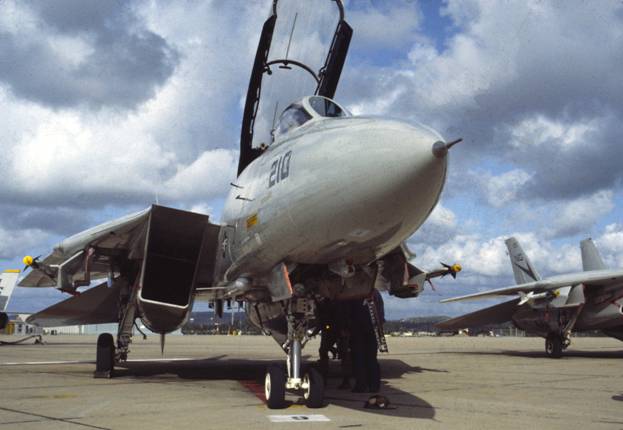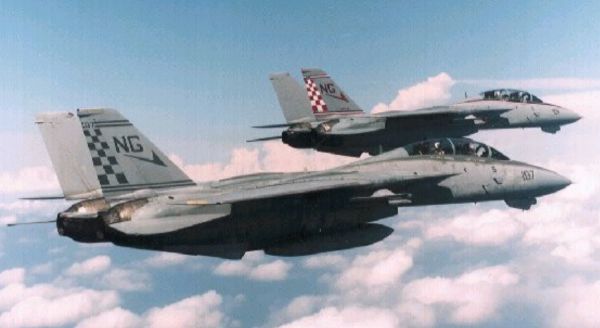by Dave “Bio” Baranek
 1 Dec 1982 - I was flying an F-14A with LCDR Steve "Drifty" Smith over the Pacific Ocean off Southern California, and our mission was to shoot an AIM-7 Sparrow on a "test and evaluation" (T&E) profile. This was my second AIM-7 shot at a target drone since I joined the VF-24 Fighting Renegades eighteen months before. This shot was an AIM-7E, although for operational missions we carried and trained with AIM-7F at the time. On this flight we also carried AIM-9Hs to finish the target if necessary - but we normally carried and trained with AIM-9L.
1 Dec 1982 - I was flying an F-14A with LCDR Steve "Drifty" Smith over the Pacific Ocean off Southern California, and our mission was to shoot an AIM-7 Sparrow on a "test and evaluation" (T&E) profile. This was my second AIM-7 shot at a target drone since I joined the VF-24 Fighting Renegades eighteen months before. This shot was an AIM-7E, although for operational missions we carried and trained with AIM-7F at the time. On this flight we also carried AIM-9Hs to finish the target if necessary - but we normally carried and trained with AIM-9L.
Test parameters for this shot required that we and the target both fly supersonic, and also required us to launch at a specific range and approach angle to the target. Instead of an explosive warhead, this missile had a telemetry package sending information to engineers on the ground. We would approach the target about twice as fast as on most training intercepts, so I had to closely watch the radar and carefully control the run. If you've ever run supersonic intercepts, you know things move much faster than intercepts run at .5 or .6 IMN (indicated Mach number).
The firing run happened about 4 pm on a Wednesday afternoon, in designated airspace over the ocean about 100 miles west of Los Angeles. The AQM-37 target drone was launched from an A-6 and proceeded on a southern heading. We were headed north, and I detected the A-6 at long range, 60 or 80 miles as I recall. This agreed with the calls we received from our controller and I started to feel comfortable. As we approached the planned launch range, Drifty went to max burner and we accelerated through Mach 1. I thought about how little drama there was; if I was not looking at the airspeed indicator I wouldn't know when we went supersonic. The A-6 reported launching the drone, and seconds later I detected it as a new target. The A-6 made a hard 180 to leave the area, and we commenced the run; range to the target was about 30 miles. We closed at over 2,000’ each second (F-14 and target combined speeds).
I was working with Drifty to carefully manage our approach: "Come right 10 degrees." "Back to 350." "Climb to 28 thousand." He was also helping by reading the info available on his repeat display up front. Even though RIOs were responsible for intercept control, most pilots knew how to run intercepts. Drifty had been a RAG instructor so he was great in a tough situation. One minute after the start we were at the planned range and angle to launch the Sparrow, and I pushed the "missile launch" button in the rear cockpit to launch the 500-lb weapon. It came off the jet with a strong thump – explosive charges ensured it cleared the plane in a wide range of airspeeds and maneuvers – and rocketed out ahead of us. I told Drifty to make a hard right turn. I had hesitated for a second or two, and I knew I'd be in trouble.
As we made our turn I looked at the small scope in front of my face and watched the target blip drift toward the left side. As it neared the edge of the screen I told Drifty to come back left in a hard turn. I had been running intercepts since Pensacola, but at these speeds things were happening fast. Drifty rolled the jet left to 90º and put on a good pull as we sliced through the evening sky. We were doing Mach 1.1 and pulling about 5 g. With our wings purposefully swept all the way back at 68º and the burners ablaze, I'm sure it would have looked cool if there had been anyone to see us.
I sweated the radar picture: I had two small green lights indicating the radar was still locked on the drone, but the track was near the edge of my scope and if it went off the scope that meant the radar antenna physically could not follow the target. If that happened our radar would break lock, the AIM-7 would "go stupid," and I would have to try to find that little drone again. That was hard enough when fighter and target were going 300 knots or less; at over 600 knots...I didn’t want to think about it. Halfway through the turn my "radar lock" lights went out. With sincere disappointment – thinking I had messed up the intercept – I told Drifty, "Broke lock, going to search"...dammit!
Drifty drawled, "Bio, relax, it was a direct hit. It broke lock because the target is gone; we just blew it out of the sky."
The AIM-7E had scored a direct hit and destroyed the target. Even without an explosive warhead, the Mach 3 Sparrow hit the drone and created a small explosion in the afternoon sky. I didn’t see it, but I enjoyed it nonetheless.
The above photo shows our jet before this exact mission. We brought back the Sidewinders and the few extra Sparrows we had carried (in case one didn't work). As soon as we landed - about 5 pm - I did a quick debrief and went into another brief, and then flew to NAS Lemoore that evening to participate in an air wing strike training mission the next day.

 From the time we began flying Tomcats in 1975, the Fighting Checkmates painted our aircraft tails with checkerboard rudders, horizontal stripes at top
From the time we began flying Tomcats in 1975, the Fighting Checkmates painted our aircraft tails with checkerboard rudders, horizontal stripes at top